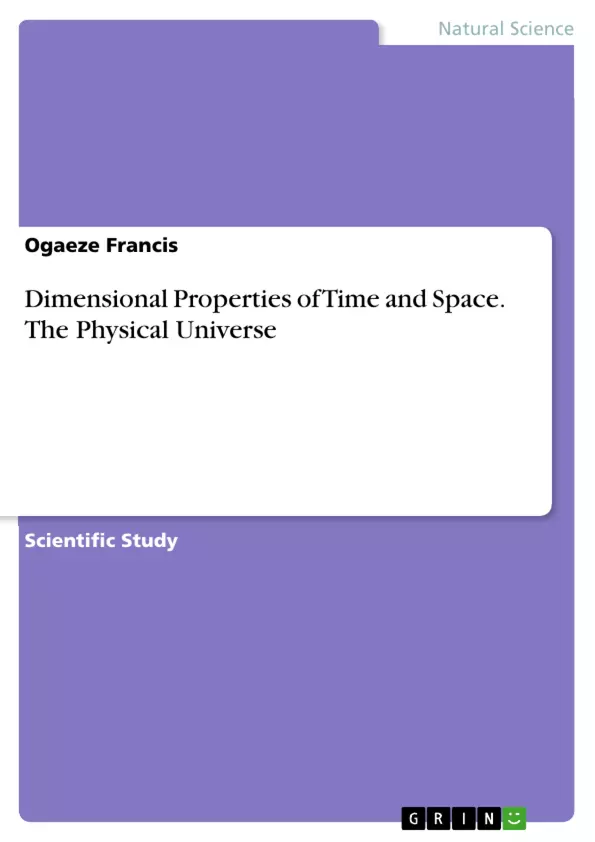According to some religions the universe was formed by the voice of God through the Holy Spirit. Christianity says the Holy Spirit hovered around the empty void until God spoke “LET THERE BE LIGHT”. In the ECKANKAR religion the Holy Spirit or the ECK flows from the heart of God (infinity) and sustains all things in the dimensions of space and time. We know a voice is a wave or a disturbance in a system. Using this ideas, this work provides a scientific framework that proves their validity, reexamining concepts we already know as valid while introducing a few. Introducing a whole new way to see and understand the physical universe from the very small to the very large.
Inhaltsverzeichnis (Table of Contents)
- DIMENSIONAL PROPERTIES OF TIME AND SPACE: THE PHYSICAL UNIVERSE
- WHAT IS IT ABOUT?
- DIMENSIONAL PROPERTIES OF TIME, SPACE, MATTER OR ENERGY
- TIME AND SPACE (PHYSICAL UNIVERSE)
- MOTION AND CAUSES OF MOTION
- Waves and particles motion
- GRAVITY
- ELECTROMAGNETISM
- QUANTUM THEORY
Zielsetzung und Themenschwerpunkte (Objectives and Key Themes)
This work aims to provide a scientific framework for understanding the universe, drawing inspiration from concepts found in various religions, including Christianity and Eckankar. It re-examines existing scientific concepts and introduces new ones, offering a fresh perspective on the physical universe. The author seeks to demonstrate the validity of these religious ideas by providing a scientific foundation for their understanding.
- The flow of essence as a fundamental concept for understanding time and space
- The relationship between time, space, and matter/energy
- The concept of multi-dimensionality and the properties of different dimensions
- The role of gravity and electromagnetism in the universe
- The implications of quantum theory for understanding the universe
Zusammenfassung der Kapitel (Chapter Summaries)
- DIMENSIONAL PROPERTIES OF TIME AND SPACE: THE PHYSICAL UNIVERSE: This chapter introduces the central concept of the "essence" as a flowing entity that defines time and space. The author explains that different rates of flow of this essence create different dimensions, with each dimension having distinct properties due to its unique flow rate. The chapter also introduces the concept of "universal constant" which represents the relationship between time and space within each dimension.
- WHAT IS IT ABOUT?: This chapter elaborates on the idea of the "essence" and its flow. It explains that matter and energy are essentially vibrations or waves within this flow, with empty space representing the normal, uninterrupted flow. The author introduces mathematical representations of this concept and provides a visual representation of the flow of essence.
- DIMENSIONAL PROPERTIES OF TIME, SPACE, MATTER OR ENERGY: This chapter delves into the properties of different dimensions. It explains that all dimensions share the same "essence," but the varying rates of flow lead to differences in the nature of matter and its properties in each dimension. The author discusses the concept of a "speed limit" for each dimension, which determines the maximum speed of light and other phenomena within that dimension.
- TIME AND SPACE (PHYSICAL UNIVERSE): This chapter focuses on the relationship between time and space as a result of the flow of the essence. The author explores the concept of the expanding universe and its relationship to the flow of the essence. It also discusses the role of gravity in influencing the perceived expansion of space, particularly for objects bound by gravity.
- MOTION AND CAUSES OF MOTION: This chapter examines the different types of motion, specifically wave and particle motion. The author explores the concept of different types of motion and their relationship to the flow of the essence. This chapter also introduces the concept of a "universal constant" that determines the speed of light and other waves in the universe.
Schlüsselwörter (Keywords)
Key concepts and topics covered in this work include: the flow of essence, time and space, multi-dimensionality, universal constant, gravity, electromagnetism, quantum theory, wave and particle motion, matter, energy, and the expanding universe.
- Arbeit zitieren
- Ogaeze Francis (Autor:in), 2024, Dimensional Properties of Time and Space. The Physical Universe, München, GRIN Verlag, https://www.hausarbeiten.de/document/1472143


